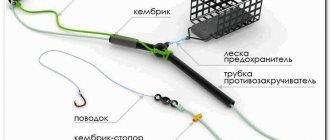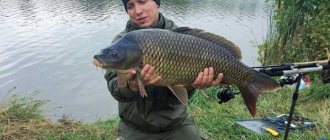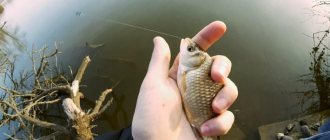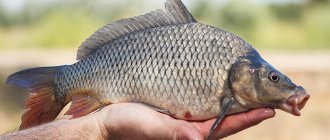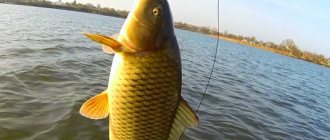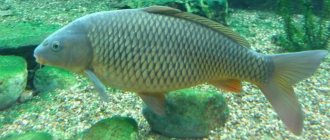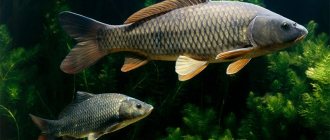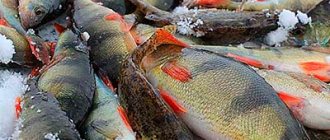Rod selection
When fishing for carp, all fishing rods are used - fly rods, Bolognese rods, match rods, and plug rods. Each of them is not universal, is intended for fishing in certain conditions and has its own advantages and disadvantages.
Flywheel
The fly rod is the lightest and most sensitive among the float rods.
Thanks to the lightweight absence of guide rings and a reel, this rod is widely used for coastal fishing for medium and small carp. The length of the fly forms ranges from 4 to 5-7 meters. Advantages:
- Ease and convenience to use;
- Ability to use thinner fishing line and equipment;
- Quick replacement of equipment;
Flaws:
- Inability to change the length of the fishing line when fishing for large carp;
- Inconveniences when fishing at a close distance, several times shorter than the length of the equipment;
- Casting limited by the length of the equipment;
- Inconveniences when using during currents.
Bologna
A Bologna rod or “bolonka” – unlike a fly rod, has guide rings and a reel, which allows you to adjust the length of the equipment.
On sale there are “lapdogs” ranging in length from 4 to 6-7 meters. This rod is used for catching carp from the shore and boat, with longer casts than the fly rod. Advantages:
- The casting range is several times greater compared to the swing;
- Ability to change the length of the main line;
- When fishing for large carp, a rod with guides and a spinning reel will allow you to evenly distribute the load on them when fishing.
Flaws:
- The weight of such rods is greater compared to their fly analogues;
- When using a thin fishing line, over time, it gradually abrades on the surface of the guide rings.
Match
A match rod (match) is a type of float rod for long and accurate casts. A flexible and durable fishing rod up to 4.5 meters long is equipped with a larger number of guide rings than a lapdog.
In carp fishing, particularly durable special plug-in carp matches are used for shore fishing up to 4.2 meters in length.
Advantages:
- The highest casting range among float rods;
- Strength and reliability of the form;
- Uniform distribution of the weight of the hooked fish throughout the entire form thanks to the large number of passage rings.
Flaws:
Heavy weight – carp matches, compared to fly and Bolognese rods, as well as classic match rods, weigh significantly more due to their reinforced design.
Plug
A plug rod is a tackle more suitable for sport fishing.
Due to their design, the casting range of plugs is greater than that of a lapdog, but less than that of match rods. When fishing for carp, it is not used as widely as the three previous types - plug rods are high cost, require a large number of additional devices for fishing with them (retractable rollers, stands), are fragile and cannot be repaired independently. Thus, among the rods described above, the most suitable for carp fishing is a sensitive and light fly rod and a long-range match rod. The Bolognese fishing rod is used most often in the absence of the previous two, but the plug is not widely used mainly because of its high cost.
Carp rods
A standard carp match rod differs from others in its durable blank with a dough weight of up to 20-25 grams, reinforced guide rings, and a reliable and comfortable handle.
The following models can be distinguished from the specialized carp fishing rods used:
- Shimano VENGEANCE AX Specimen 13-350 DL 2PCS is a plug-in two-section rod with a length of 396 cm. Thanks to the use of XT30 carbon fiber in the blank, it perfectly dampens the jerks of even very large carp.
- Daiwa BLACK WIDOW CARP 360 is a two-section carbon fiber carp rod with a length of 360 cm. Reliable and quite light with a long, comfortable handle made of EVA polymer.
- Salmo Diamond CARP is a carp rod made of IM brand graphite consisting of three sections with a total length of 360 cm. The handle is spaced apart, made of neoprene.
Shimano VENGEANCE AX Specimen 13-350 DL-2PCS Daiwa Black Widow Salmo diamond Carp 35lb-360
Rod and reel
A carp fishing rod must have a high strength life in order to fight large prey. Also important for the blank is good flexibility and shock absorption, which will allow you to dampen the jerks of the fish, preventing it from breaking the line or falling off the hook.
Recommended reading: The best silicone baits for pike perch
The fishing rod for carp is telescopic, made of carbon fiber or composite material. Its length can be 4–7 meters. A short “rod” is easier to control and is useful when fishing near aquatic vegetation and in cramped conditions. In a spacious area, you can take a long model.
The reel in classic float tackle is used primarily for storing fishing line. It is better to choose a regular inertial model with sufficient capacity and safety margin. If an inertia-free gear is selected, then its size should be 2500–4000, the gear ratio should not be higher than 4.1:1.
Gear selection
Coil selection
For fishing with a match float rod, a mandatory element of the gear is a special carp spinning reel.
Such a coil must meet the following requirements:
- The material of the reel body is light and durable alloy;
- The shallow depth of the spool allows it to be completely filled with a large volume of thin monofilament fishing line;
- Reel size from 5000 according to Shimano classification;
- Parts of the spool drive mechanism must be made of metal or durable alloy;
- Gear ratio – for fishing you need power reels that make 4.2-4.6 turns of the spool per turn of the handle;
- At least 3-4 bearings must be installed in the handle and spool rotation mechanism;
- A prerequisite is the presence of a rear friction brake;
- Bearing in the line roller;
- Reinforced handle;
- Reliable baitrunner.
Top 3 rating of the best reels
The following models are recognized as the best reels today used in carp fishing with float tackle:
- Shimano Baitrunner XT 8000 RA;
- Daiwa Black Widow 3500-5000;
- Banax Helicon 500NF;
Shimano-Baitrunner-XT-8000-RA Daiwa Black Widow 3500-5000 Banax Helicon 500NF
When fishing for carp with a Bolognese fishing rod, you can use small match spinning reels.
Line selection
When fishing, even a small carp strongly resists. This violent resistance, combined with the decent weight of the fish, dictates the need to use strong, but at the same time fairly thin and invisible fishing lines.
When fishing with match and Bolognese fishing rods, special sinking carp fishing lines with a cross-section from 0.2-0.22 to 0.3 mm are used; for a fly fishing rod - thinner ones with a cross-section of 0.18-0.2 mm.
The most popular brands of monofilament fishing line are:
- Shimano Blue Wing Line 100MT;
- Power Phantom Clear;
- Aqua PA Ultra Soft Match;
Shimano Blue Wing Line 100MT; Power Phantom Clear Aqua PA Ultra Soft Match – a new product on the fishing line market
Hooks
Special hooks are used to catch carp
Their feature is:
- Strength – the carp hook should spring back, but not bend;
- Long forend;
- Very sharp, inwardly curved sting;
- Matte or black hook surface;
- The ring for the fishing line is bent inward;
The size of the hook is selected depending on the type of bait and the size of the carp living in the pond. For catching medium-sized carp, hooks Nos. 8-10 are sufficient; for large specimens, hooks Nos. 6-8 are sufficient.
Among the manufacturers most often used in carp fishing are hooks from:
- Korda;
- Fox;
- Gamakatsu;
Gamakatsu Fox Korda is a company that has long established itself in the hook market
Sinkers
The shape and weight of the sinker plays an important role in the rigging of a float rod.
- To increase sensitivity and reduce the noise produced by sinkers in contact with water, when casting, the entire load is divided into 2-3 parts.
- Lead pellets of different weights are suitable and convenient for light fly fishing rods.
- Such sinkers are secured by carefully clamping the fishing line in the slot made in them.
- For match gear, the main part of the load consists of the corresponding weight of the olive; the pellets are installed only at the leash
Float
When fishing for carp with a fly rod or Bolognese float rod, use floats with an elongated, spindle-shaped body, a long antenna, and a narrow keel. For fly tackle, take lighter and more sensitive floats with a load of up to 1.5-2 grams, while for “lapdog” take load-lifting alarms capable of holding a load of 2.5-3 grams.
Match tackle requires a special float for long casts - a waggler, which has a long thick antenna, a spindle-shaped body and its own weight in the form of washers fixed in place of the keel.
Leash
The use of a leash in float gear for carp fishing is mandatory. The length and cross-section of the fishing line depends on the type of gear used:
- When using a fly rod, the leash is made 15-20 cm long from thin fishing line with a cross-section of 0.15-0.16 mm.
- For match gear, a thicker leader line with a cross-section of up to 0.18 mm and a length of up to 40-50 cm is used.
Fly float tackle for carp
A fly rod makes it possible to catch carp both in the current and in still waters where there is a lot of aquatic vegetation and snags. During fishing, a fly rod allows us to almost completely control this process and direct the carp where we need it, preventing it from going into snags. The disadvantage of fly tackle is that we are limited in range by the length of the rod (as a rule, fishing takes place within a range of up to 15 m). Also, fly tackle does not require the presence of a reel, which means we are deprived of a friction clutch.
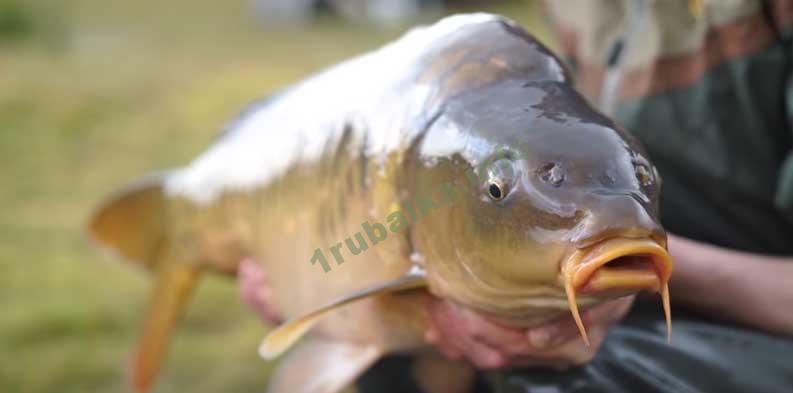
Rod
A carbon fiber blank is 5-7 m long; longer blanks are much heavier and have greater windage. It’s impossible to say for sure based on the action, the soft form of the slow action perfectly absorbs the jerks of the fish and at the same time it is more difficult for us to control the process of fishing and the fish can freely go into snags or reeds. Therefore, if the fishing point is free of vegetation, and a large carp is hooked, use a slow-action rod; if there are snags and algae, it is better to use a medium-action blank with a flexible and durable whip.
The fly rod does not have rings, and the fishing line is tightly attached to the tip of the rod using a connector.

Shock absorber installation
Especially for carp fishing, it is advisable to additionally equip the fly float rod with a rubber shock absorber. Read more about this fishing method here.
fishing line
Carp monofilament, thickness 0.2-0.28 mm, habits with a diameter of 0.18-0.26 mm, length 15-25 cm, when fishing in early spring the length can be increased to 50-70 cm.
Hooks
For fly float tackle for carp, hooks No. 6-14 according to the international classification are used. Sharp and durable, with a sting curved inwards.
Floats
Weight up to 5 grams, light floats weighing 1.2-1.5 grams, very sensitive, but in the presence of waves, wind and current, you may need heavier ones.

In fly fishing, drop-shaped floats are used, and in the current, a reverse drop. Also, in a standing pond you can use cigar-shaped floats.
Float rod equipment
Blind equipment
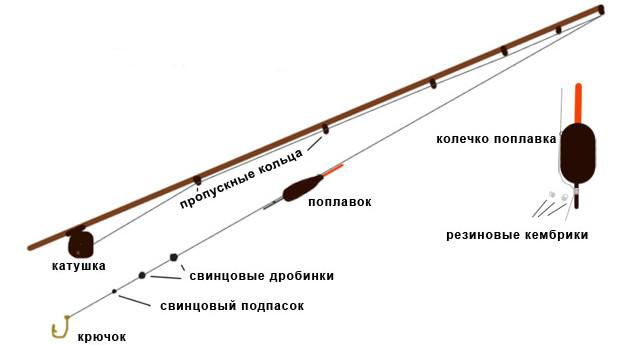
It uses a thin and strong fishing line with a cross-section of up to 0.18-0.2 mm, a small and sensitive float loaded with pellets. The advantage of such gear is its sensitivity and stealth. The most significant disadvantage is the fixed length of the equipment, which cannot be quickly changed during the fishing process.
Sliding equipment

Sliding equipment is more active. It is used in carp fishing with Bolognese and match fishing rods. With this installation, the entire equipment can change its length using a reel and a rod equipped with rings. Unlike the blind one, it is rougher, but at the same time it makes it possible to make long casts, the magnitude of which is limited only by the supply of fishing line on the reel spool.
Loading the float
A properly loaded float will allow you to see even the most careful bite of a cautious carp.
On the fly and Bolognese fishing rods, the float is surrounded with lead pellets of varying weights or one olive. To increase sensitivity, the entire load is divided into:
- The main load is a set of pellets or an olive, located 20-25 cm above the place where the leash is attached to the main line.
- Sub-grazing is about 10-15% of the entire float load. It consists, like the main load, of pellets, but smaller ones weighing 0.1 grams, and is secured at the junction of the leash with the main fishing line.
Very often the main load is divided into several parts spaced 5-10 cm apart. Assembling such gear is not difficult.
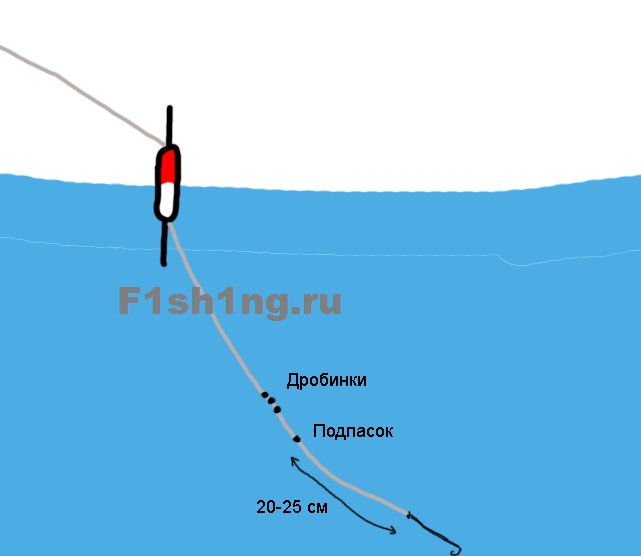
The main load should submerge the float to the base of its antenna, while the underweight should regulate the height of the antenna tip protruding above the surface of the water.
Rough loading of the float is carried out at home - in a bathtub, barrel, bucket - securing the main load. The alarm is more finely tuned by selecting the weight of the graze directly on the reservoir. The degree of immersion of the antenna is adjusted depending on the fishing conditions:
- In case of strong wind, current, or wave, the antenna should be loaded no more than 1/3 of its length;
- In calm water conditions, for greater sensitivity, leave only half of the antenna above the water.
Bait for carp
Feeding is the key to successful fishing. In terms of efficiency, homemade baits are often not only not inferior, but even superior to store-bought ones. It is worth noting that bait for carp is extremely similar to bait for crucian carp. Some brands even produce bait for two types of fish at once.
Recipe No. 1
- In winter, you can mold the bait into balls, this allows you to more precisely deliver it to the right place, even with a strong current,
200-300 grams of crackers from black, not moldy bread are carefully crushed; - Add 250-300 grams of milk powder and soy flour, 200 grams of egg powder to the resulting mass;
- Mix thoroughly until the mixture becomes a homogeneous granular mixture, adding 1 teaspoon each of fine salt and sugar;
- Mix with dry red clay;
- Before fishing, the bait is moistened to a thick viscous state;
Recipe No. 2
- Millet, pearl barley and semolina are placed in a large container and filled with water;
- Cook over low heat until each ingredient is completely cooked.
- Add a little unrefined vegetable oil, 2-3 tablespoons of honey, breadcrumbs, makukha (cake) to the resulting porridge.
- Let the bait sit and thicken
Watch the process of preparing bait online:
Purchased bait
Among the purchased baits for catching carp on a float, the following mixtures are popular:
- Dunaev Karp,
- RS Carp XXL,
- Traper Big Carp
Dunaev Carp-Crucian RS Carp XXL Trapper big carp
Aromatization
Since carp are caught in warm water, the use of flavorings both as additives in bait and in the composition of the bait plays a huge role in the quantity and quality of the catch. To add an aroma that attracts fish, use:
- Anise;
- Vanilla;
- Honey;
- Garlic extract.

Typical flavorings for carp
Feeding process
- To feed carp, prepared bait in a bucket or other container is mixed with soil - pre-prepared clay, sand, or simply earth taken from the shore. After the soil has been distributed evenly between the bait particles, they begin to add water and just as thoroughly knead the resulting mass until it becomes thick. From the mixture, left for 5-10 minutes, 10-12 balls of different density with a diameter of 5-7 cm are molded.
- 3-4 balls are thrown into the fishing spot for starting feeding, two of them are tightly molded, and the rest are looser. This is done because denser balls will disintegrate slowly; although they will not attract fish immediately after casting, they will still hold them later. Balls that are looser will begin to collapse almost immediately when they hit the water, attracting fish to the fishing spot. This scheme will allow you to quickly attract the carp with a large portion of bait from the second balls and then keep them in a certain place for a long time from the gradually falling apart first ones.
- If the bite is weak, they resort to additional feeding - for this, the remaining balls are sent to the fishing point according to the same principle as during the starting feeding.
- In order to attract carp, you need to throw bait as accurately as possible to the place where you plan to fish. If the fishing distance is very large, then special slingshots are used for feeding, with the help of which the balls are not only thrown to the required distance, but also ensure high accuracy of their hits.
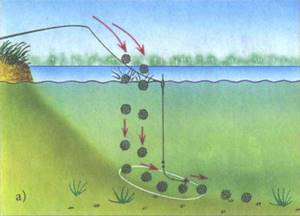
When feeding, do not forget about the bottom topography, in which too dense balls will roll deeper down.
Baits and attachments for carp fishing
Among the baits, carp prefers:
- Undercooked new potatoes;
- Canned or boiled corn;
- Boiled peas;
- Millet;
- Bread crumb;
- Pea mastyrka;
- Steamed grains of rye or wheat;
- Semolina chatter;
- Boyles
In addition to baits, especially in spring and closer to autumn, carp also take the following baits:
- Maggot;
- Dung and earthworm;
- Bark beetle;
- Shitik.
Technique for catching carp with a float rod
Choosing a fishing spot
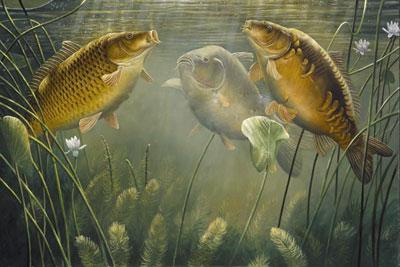
Carp lives almost everywhere, populating reservoirs with both standing water and moderate currents. Carp prefers the deepest places with a hard clayey and slightly silted bottom, abundant in aquatic vegetation. Most of the day it stays at depth, at dawn and after sunset it enters shallow muddy bays to feed.
- In ponds , lakes and large reservoirs, to catch it, choose places with a depth of 2-3 meters near thickets of egg capsules, under tree branches overhanging the water, near a flooded snag.
- In rivers, carp are looked for in deep backwaters and creeks with thickets of reeds and cattails, on wide reaches with a moderate current.
Fishing in still water
Fishing for carp in reservoirs with stagnant water begins in late May - the first ten days of June, after the fish have spawned, and continues until mid-September.
In small bodies of water, as well as when fishing near the coastline, use a fly float rod with light equipment. If you plan to catch carp in places remote from the shore, at a distance of more than 15-20 meters, match rods are used. Before fishing begins, the area is fed with bait balls. The main attachments are corn, steamed peas, mastyrka.

In addition, the boat will be indispensable when fishing in the channel ditches of reservoirs remote from the shore, and on the edges of artificially dug wintering pits.
The most suitable tackle for fishing from a boat is a short fly rod or Bolognese rod. They feed both with the help of balls prepared on the shore, and with a feeder lowered at the fishing site.
Fishing on the current
On rivers, carp are most often caught in places with weak or moderate currents, in deep backwaters and oxbow lakes, in holes under steep banks bordering shallow waters. Carp does not like straight sections of rivers with a rocky bottom, devoid of coastal aquatic vegetation.
- Long Bolognese and match rods are used to catch river carp. Fly tackle is used when fishing in backwaters and old fish.
- Feeding is done with the most dense balls that wash out in water for a long time.
- Along with vegetable baits, river carp take shells well for meat.
Fishing in muddy water
Changing the transparency of the water in a river, lake, or reservoir significantly improves the carp's bite - in such an environment the fish are less timid; due to the turbidity, they cannot see as well as in clear water. At this time, the carp more confidently approaches the shore and rises to mid-water.
To catch carp in muddy water, use light fly tackle with baits and bright colors that attract fish - corn, peas. The bait is thrown into the fishing area in smaller portions.
Fishing depending on the bottom and soil
Carp is a fish that prefers to stay near the bottom most of the day. This feature leaves its mark when fishing for it in places with bottoms of different composition and topography.
So, in reservoirs where there is enough silt at the bottom and its topography is uniform, carp can be caught anywhere. The situation is opposite with a more complex bottom topography and the local nature of silt deposits on it. In this case, using an echo sounder, a marker float or measuring the bottom with a heavy sinker, they find muddy pits, depressions, dumps and edges where carp are likely to stand
Carp activity in the morning and evening
Daily peaks of carp activity depend on water temperature and change throughout the fishing season.
- In spring, carp are most active from noon to sunset - when the water is warm enough. It takes weakly in the morning and evening.
- In summer, during the day, carp experience two peaks of activity - evening and morning. At this time, the water cools down and the carp goes to shallow waters, to the reed thickets. Night bite of carp can occur on very hot days, when the water warms up so much that it cools down only at 22:00.
- In autumn, as in spring, the greatest activity of carp is observed from lunch to evening, and on cloudy cold days the carp is passive and practically does not feed.
Carp fishing at different times of the year
Spring
Carp is a heat-loving fish.
In the spring, its active fishing begins only when the water temperature in its habitat reaches + 140C. This usually happens by the end of April-beginning of May, but in a cold spring, fish begin to be caught normally only towards the end of the last spring month. Choosing a location.
In the spring, as the water warms up, carp begin to emerge from their winter shelters, occupying areas of reservoirs with a depth of up to 2 meters. The most promising at this time will be the upper edges of the holes, the shallows near the thickets of last year's reeds.
Tackle.
Since carp stand near the shore at shallow depths in the spring, the most suitable gear would be a light fly rod up to 5 meters long. The equipment should be thin enough, but at the same time durable:
- The float is light and sensitive with a load of up to 1 gram;
- Line section 0.18-0.2 mm;
- Leash 0.14-0.16 mm;
- Hook No. 8-10.
Lures and lures.
Among carp baits in spring, more nutritious baits are used:
- Muckworm;
- Bloodworm;
- Maggot;
- Dragonfly larva.
Fishing tactics.
When fishing in spring, it is worth considering that carp are not yet as active as in summer. The fish are most active from lunch until 4-5 pm - at this time the water is warmest.
In order to catch it, you need to choose the most suitable place, moderately, so as not to overfeed the fish, feed it with a mixture that includes the bait used in fishing - chopped worms, small food bloodworms. In order not to scare away the sensitive carp, you should not often re-throw the tackle, often come close to the water, or make extraneous noise. In spring, the key to successful carp fishing is patience and silence.
Watch a video on carp fishing for free:
Summer
Choosing a location.
In summer, carp spend most of the day at a deep depth of 3-5 meters or more near tall reed thickets casting a shadow, in places where underwater springs flow, near a flooded snag. In the morning and evening, when the water has not yet warmed up or has begun to cool down after the heat of the day, the carp rises to shallow waters overgrown with grass, rich in food, where it feeds throughout the night. Carp takes it well on cloudy days with rapidly passing rains.
Tackle.
In summer, the entire arsenal of carp gear is used:
- float rod - light fly rods are used on lakes and ponds; for fishing in large bodies of water, match and Bolognese rods are more convenient;
- bottom gear – feeders and pickers, classic bottom fishing rods;
The equipment on the float rod, bottom rods and feeder is coarser and stronger than in the spring - the cross-section of the fishing line reaches 0.25-0.27 mm for the float rod, 0.3 mm or more for the feeder and bottom. The size of the hooks, depending on the nozzle, ranges from No. 10 -12 to No. 8-6.
Lures and lures.
In summer, carp gradually switches to a vegetarian menu, preferring:
- canned corn kernels;
- steamed peas;
- undercooked new potatoes;
- pea mastyrka;
- mash of semolina and water;
Among the baits, carp takes a worm, maggot
Fishing tactics.
In summer, although carp are more active than in spring, they still have plenty of food and must be forced to bite. Therefore, when summer carp fishing, supplementary feeding is a prerequisite - mixtures can be either purchased or prepared independently. The main thing is that the bait that gets into the water creates turbidity and attracts fish with its smell and variety of ingredients - corn, peas, breadcrumbs, etc. Just like in the spring, carp do not like unnecessary noise.
Autumn
Choosing a location.
With the onset of autumn cold weather and a gradual decrease in water temperature, carp begin to move to the deepest places in reservoirs. And if at the beginning of autumn the carp still visits its summer feeding grounds, then closer to winter it slides into pits and pools. As in spring, carp in autumn bite more often during the day, when the water warms up as much as possible.
Tackle.
In early September, when the water has not yet cooled down much, a float rod is still used to catch carp. In October and November, a feeder is a more catchy tackle, thanks to which you can catch carp from holes located far from the shore.
Lures and lures.
The most preferable baits for carp fattening up for the winter at this time are dung worms, bloodworms, and maggots. He takes plant baits much less often than in summer and then as part of “sandwiches” with bait.
Fishing tactics.
Autumn carp fishing requires not only knowledge of the deep places of the reservoir where large carp can stand, but also proper feeding and use of bait. Feed in small quantities, adding chopped worms or small bloodworms to the mixture; flavorings are added in slightly smaller quantities than in summer - cold water does not conduct odors well and its high concentration near the fishing site can scare away the fish. Baits should be chosen small in size - if it is not possible to place a medium worm on the hook, it is better to use a bunch of bloodworms secured with a silicone rubber band, 3-5 maggots pierced across the body.
Winter
Choosing a location.
Fishing for carp in winter is not a common occurrence - as a rule, when the water temperature drops greatly, carp falls into torpor and remains there until spring. But there are also exceptions to the rules. Thus, carp have recently begun to be caught quite successfully in flowing and deep ponds, on rivers and reservoirs. For fishing, they choose deep wintering holes with a slow current, coastal snags with underwater springs gushing in them, pools at the mouths of rivers or streams flowing into large bodies of water.
Tackle.
Carp are caught in winter using jigs and winter float gear. When choosing a fishing line, take into account the significant weight of the fish and its weak, but still weak, resistance - a fishing line with a cross-section of up to 0.22 mm is more suitable.
Large jigs with a diameter of 5 mm or more with strong hooks No. 8-12 are used.
Larger hooks are also placed on the float tackle.
Lures and lures.
Among the baits, carp is most often caught on a bunch of bloodworms.
Fishing tactics.
Winter carp fishing requires increased patience and attention from the angler. At this time, the fish feed much less and less often than in the summer, so having identified the treasured place, you need to feed it and abandon the gear to wait - the bite begins suddenly and ends the same way. Feed in small portions so as not to overfeed the fish.
Carp bite in winter on the first and last ice. The best carp bite is observed during thaws that last for several days. Its peak occurs in the afternoon and lasts from several tens of minutes to 2 hours.
The bite in the dead of winter weakens, or even stops completely. It is not possible to catch carp in January-February even on a paid site.
How to catch carp with a fishing rod
You can catch very large carp with a fishing rod near the shore. And if you’re dealing with a school of small fish, you can catch as many fish as you like...
Which fishing rod is better for carp?
A cheap fiberglass telescope with rings and a reel turns out to be a good fishing rod for carp. Very expensive fishing rods designed for coastal carp fishing are similar in characteristics to such a telescope, with the exception of weight. They have a soft structure (they bend from the butt) and a huge margin of safety. But the weight of the rod in carp fishing is not so critical, since recasts are infrequent.
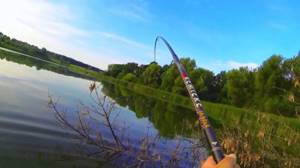
Most fishing enthusiasts have a 6-7 meter heavy but strong fishing rod in stock - a suitable option for the fishing considered here. Only the cheapest and flimsiest versions of telescopes are not suitable.
Almost any inexpensive inertia-free reel with a safety margin will do. Its tasks are modest: to store the fishing line, control the clutch with the initial jerk of the hooked fish, and bring the carp to the shore without breaking. Expensive branded reels are not used on such equipment; their useful qualities remain unclaimed here.

- Thus, a budget medium-soft telescope with a simple reel turns out to be suitable gear for catching large carp under the shore. A fishing rod that is good for catching carp near the shore can cost mere pennies.
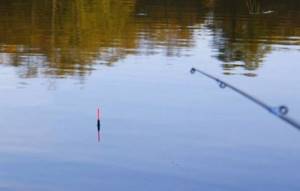
Carp rig for fishing rod
More often the carp bites very gently. In most cases, anglers do not notice this due to the roughness of the equipment. The fish fiddles with the bait, sucks it in and spits it out, treating it with suspicion. This manifests itself in the form of subsidence of the float, twitching. The fisherman either does not notice this at all, or believes that the soft bait has been eaten by small things. But it was carp.
For carp fishing, a classic approach to constructing sensitive equipment is recommended. Its mass will directly depend on the diameter (and therefore on the windage) of the fishing line. The diameter depends on the angler’s opinion about what kind of fish he is going to catch.
If we were talking about fishing with a plug, then without any options it is recommended to use equipment for carp weighing no more than 1 gram. To register twitches, and the opportunity to catch carp on the plug with a clear hook on an uncertain bite. But for a fishing rod you will have to increase the weight of the equipment several times.
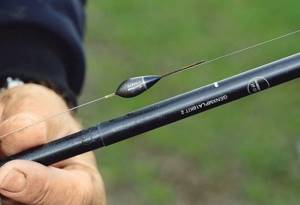
How to choose fishing line, weight and float
At the beginning of fishing, it is recommended to choose a main line with a diameter of 0.14 mm, and a leash with a diameter of 0.12 mm. This will give you the opportunity to count on success in the fight against 2-kilogram carp. Here the weight of the load can be about 1.5 grams for calm weather and up to 3 grams for wind. Which also corresponds to quite sensitive equipment.
In stock you need to have other heavier equipment on thick fishing line for large carp.
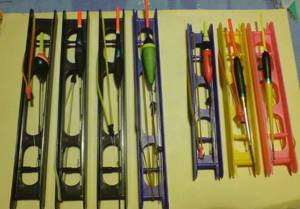
The length of the rigs is one meter shorter than the length of the rod. They are connected loop to loop with a supply of fishing line wound on a reel and passed through the rings. The diameter of the main line on the reel should be in the range of 0.25 - 0.3 mm.
A float for catching carp with a fishing rod in still water is chosen to be a universal one - with a long thin antenna and a buoyant body in the form of an elongated drop. It is quite stable on the wave. And some loss of information about bites on the rise is not so important, since carp rarely bite in this way. It is more important that the antenna registers careful submergence.
Thus, armed with a durable telescope with a dozen different accessories for it, you can go to a pond and try to catch carp with a fishing rod under the shore.

Mistakes in feeding carp when fishing with a fishing rod
The composition of the bait is not as important as the tactics of its use. In summer, carp should be fed abundantly and in abundance.
Common mistakes made by anglers are as follows:
- Fishermen feed little, but they believe that the fish do not bite because they have eaten too much.
In fact, the fish quickly eats the food and swims away to a neighbor who feeds more generously. In summer, fattening fish are difficult to overfeed. And if a flock of medium-sized carp comes in for bait... In general, to keep the carp in place all day, as a rule, 5 kilograms of high-calorie food is not enough. Need a bucket.
- Another mistake is to scatter bait around the area so that the fish come to the place.
This leads to the fact that the bait is eaten very quickly by the fish, which generally has no chance of finding out why it was fed. The bait on the bottom is only discovered by chance a couple of times throughout the day. By scattering a little food wider at the beginning of fishing, the angler still has a chance to catch a carp with a fishing rod, but only by accident.
Basic feeding rules
- The bait is made only from fresh ingredients or branded ones are used.
- There is a lot of bait.
- The fishing point is determined after preliminary fishing with a fishing rod.
- The bait is cast in front of the float by 10 - 20 cm. And on a steep bottom - by 30 - 40 cm.
- Starting feeding of carp with balls is done, 90% of the feed is consumed.
- Supplementing carp with large balls near the shore is not recommended, due to the high probability of scaring off the school. Supplementary feeding is carried out abundantly, but with grain, using a slingshot and shooting at a float. Or tossing grain by the handful.
The bait can consist of any ingredients that the carp like. Can be fed with granules.
An example of a regular bait
- Breadcrumbs - 1 kg
- Ground gingerbread - 1kg
- Sunflower cake - 1 kg
- Boiled pearl barley – 1kg
- Canned corn - 0.5 kg
- Chopped worms - 0.5 kg
- The bait is flavored with juice from jars of canned corn.
- But here you can add (replace) wheat, millet, peas, boilies, semolina, hemp...
The method of constant supplementary feeding is also effective for carp. This creates excitement in the school if the fish is active. Supplemental feeding is done after each recast, or every 2 - 4 minutes. A little mixture of grains and larvae and worms is sent to the fishing point.
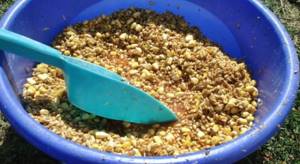
Top 5 baits for carp
- Semolina with honey in a large ball (carp prefers soft fluffy bait).
- Soft steamed mucous barley with sunflower oil (cake).
- Dung worm in a bunch.
- Canned corn in a bunch on a hair (for large carp, especially when fishing at night, the bite occurs slowly, you can hook only after 1 second, when the float begins to move to the side or disappears under the water).
- Steamed peas, or soft dough with crushed peas.
All baits are made as large as possible so that they stand out against the background of the bait, baited on a hook No. 14 - No. 10 with a long shank made of thick wire.

Finding a fishing spot takes half the time of the entire fishing trip
The usual tactic for catching carp with a fishing rod is to put the main effort into choosing a fishing spot. If you want to catch carp, you need to find a place where it is.
You can ask the locals, and the more people who tell you about the reservoir, the better. Then you need to go around the pond, even if you have been fishing recently... The fish can change its location.
Carp sticks to snags, the borders of thickets on non-swampy silt, clay edges and shallow waters. But there may not be carp in these places if they are baited by fishermen, who with their fishing lines can drive fish from anywhere into the most remote, inconspicuous bay...
Catching carp with a fishing rod at two points
As a result of the search, a fishing location is selected. The usual practice when fishing for carp with a rod is to feed two points into which the bait can be cast with a rod from one location. In this case, there can be 5 - 7 meters between them.
If possible (if there is a free bank and a supply of food), then the 3rd point is also fed, to which you can move ten meters to the side. Such coastal feeding more reliably keeps a school of small carp near the shore and increases the likelihood of encountering large carp.
Casting points for gear are selected carefully based on depth, orientation and distance. Re-casting should be carried out at exactly the same point, where the bait was placed.
Ordinary fishing with a fishing rod for carp, on a typical body of water...
Fishing is carried out alternately at each point
After catching a fish, the point is usually allowed to rest by throwing a little mixture of grains into it, and they try to fish in another. Recasting the fishing rod will show where the fish are currently located.
It is not recommended to fish with two tackles at the same time at different points. It just makes it difficult to concentrate. It is much more effective to do periodic fishing with one tackle.
You need to start fishing with the lightest equipment, waiting for uncertain bites, and making the descent so that there is 2 centimeters of the leash at the bottom. But in windy weather you have to anchor with a heavy padding, placing it 5 - 7 centimeters from the hook.
But, if the carp is fattening on bait, it is recommended to immediately replace the equipment with a stronger one with a 0.2 mm fishing line in order to quickly move the hooked carp away from the point, since it can disperse the entire flock. And also use distributed loading, since very often rushing carp weighing 1 kg take falling bait.
Carp fishing time is night
Many people believe that carp should be caught with a fishing rod in the morning, so they come fishing early, trying to improvise on the go with both the fishing location and the bait, and keep it within 6-10 hours of daytime in order to catch carp. Usually nothing good comes of this.
In many pressurized reservoirs, fish hide from anglers at dawn. And it approaches the shores only at night, when they “calm down,” and the “horde,” for the most part, disperses to apartments and houses.
Carp, especially large ones, come to the shore more often at night and you can effectively catch them with a fishing rod after dark.
Many fishermen say that the light of the lantern scares away the carp, and it will not come to the shore, where the beam emanating from the rotating head is constantly darting.
This is probably true, and it is better to wait for the carp in complete darkness, operating by touch, and watching for the firefly on the float.
But there is also an opinion that fish are even attracted to a light spot on the surface of the water. Those. you need to install the lantern as low as possible so that the light beam reflects from the surface of the water and does not penetrate under it.
At the same time, the fishing point and the float in it are perfectly illuminated. The lantern must remain motionless at all times. And you can do illumination on the shore, unless you hide behind a tent.
They can also fish with a luminous float, just like nighttime carp fishing with a fishing rod...
Not only for bait
Casting to the same point, crowded with food, is, of course, correct if we are talking about small fish. But it often happens that you can’t wait for a large carp to bite, even at night using bait. What is the reason?
It turns out that large individuals do not show up for bait, probably out of caution, they are nearby - 2 - 10 meters away, watching what is happening. The main thing is that they often stand not further, but closer to the shore in the darkness of the night...
Therefore, it is useful, if only small things are biting, to periodically cast to the side. The tactic of two feeding points significantly expands the angler’s ability to find large carp near his place.
At night, in carp reservoirs, it is common to bite under the shore of individuals weighing 5 - 8 kilograms. Therefore, you need to work with durable equipment. Pay more attention to the water's edge - most often the carp is 1 - 3 meters from the shore.
Disadvantages of catching carp with a float rod
In addition to the advantages, fishing for carp with float tackle has several disadvantages:
- Very often, fishing rods that are not designed for heavy loads break under the pressure of particularly large carp;
- In windy weather and with strong waves, even the longest and correctly loaded float will not be able to hold the bait in the fishing spot and most clearly signal a carp bite;
- Since most float fishing rods have an impressive length of more than 4-5 meters, this constrains the fisherman to more actively search for promising places for carp fishing on reservoirs with shores overgrown with bushes and trees.
CHOOSING A CARP ROD ACCORDING TO FISHING CONDITIONS
On small bodies of water, say, on paid stocked lakes, very huge carp are rarely found, so a rod with a high test load value is not needed here.
If you plan to fish at long distances using feeders and PVA bags, then the product must meet the appropriate test. The same applies to casting gear in snags and grassy areas. If the hooked fish rushes into the saving vegetation or snags, a rod with a weight of at least 3.25 LB will be able to turn it around.
For clean and relatively tight bodies of water, it is unwise to purchase a strong blank; for such, you can get by with gear with a 3 LB test. However, let’s not forget that it only works at short and medium distances. If the bait needs to be presented at a distance of 100 meters from the shore and further, then it is more rational to use a 3.75 LB rod.
